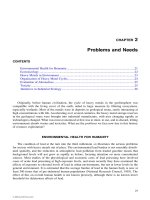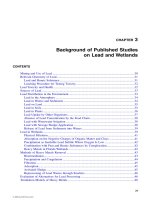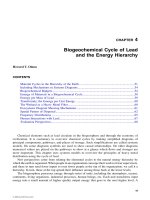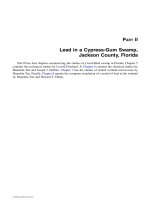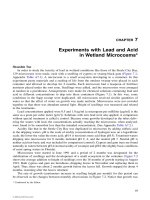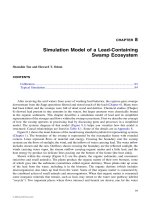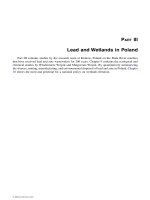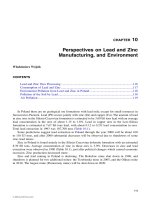Heavy Metals in the Environment: Using Wetlands for Their Removal - Chapter 10 potx
Bạn đang xem bản rút gọn của tài liệu. Xem và tải ngay bản đầy đủ của tài liệu tại đây (246.73 KB, 5 trang )
115
CHAPTER
10
Perspectives on Lead and Zinc
Manufacturing, and Environment
Wlodzimierz Wójcik
CONTENTS
Lead and Zinc Ores Processing 116
Consumption of Lead and Zinc 117
Environment Pollution from Lead and Zinc in Poland 118
Pollution of the Soil by Lead 118
Air Pollution 119
In Poland there are no geological ore formations with lead only, except for small resources in
Jaroszowiec-Pazurek. Lead (Pb) occurs jointly with zinc (Zn) and copper (Cu). The amount of lead
in zinc ores in the Silesia-Cracovian formation is estimated to be 3.69 E6 tons lead with an average
lead concentration in the ores of about 1.15 to 1.8%. Lead in copper ores in the Low-Silesia
formation is estimated at 7.67 E6 tons lead, with about 0.12 to 0.2% lead concentration in ores.
Total lead extraction in 1993 was 107,700 tons (Table 10.1).
Some predictions suggest lead extraction in Poland through the year 2000 will be about 100
to 110 E3 tons, and after 2000 substantial decreases will be observed due to shutdowns of some
zinc–lead mines.
Zinc in Poland is found mainly in the Silesia-Cracovian dolomite formation with an estimated
8.39 E6 tons. Average concentration of zinc in these ores is 3.9%. Decreases in zinc and lead
extraction were observed in 1990 (Table 10.1), just after political changes which caused economic
recession. Zinc production decreased more.
Zinc and lead mining in Poland is declining. The Boleslaw mine shut down in 1996, and
shutdown is planned for two additional mines: the Trzebionka mine in 2005, and the Olkusz mine
in 2010. The largest mine (Pomorzany mine) will be shut down in 2020.
L1401-frame-C10 Page 115 Monday, April 10, 2000 9:59 AM
© 2000 by CRC Press LLC
116 HEAVY METALS IN THE ENVIRONMENT: USING WETLANDS FOR THEIR REMOVAL
LEAD AND ZINC ORES PROCESSING
Removal of lead in zinc–lead ores by flotation processes produces commercial concentrates.
They contain about 73% lead at the Trzebionka mine and 53% at the Boleslaw mine (Table 10.2).
Flotation of copper ores does not concentrate lead. The concentrates of copper contain between
2.16% lead (at Rudna) and 1.17% lead (at Polkowice). Lead is recovered and concentrated as raw
lead in the next step, metallurgical processing of copper ores.
Zinc concentrates are produced as by-products of processing of zinc–lead ores. At ZGH Bole-
slaw mine these concentrates contained 46% zinc. Production of zinc concentrates decreased after
1989 to about 150,000 tons zinc/year (Table 10.2).
Lead and zinc are processed into metallic forms in the metallurgical mills. There are two basic
metallic forms of lead: raw and refined. Raw lead is produced in Miasteczko Slaskie, ZGH Orzel
Bialy, HM Glogow, HMN Szopienice, and ZPWMN Wtormet Bytom (Table 10.3). Concentration
of lead is between 96 and 99%.
In 1989 about 55% of raw lead production was from recycled wastes. In 1993, 46% was from
recycled wastes, but the total amount of raw lead decreased from 45,700 to 35,500 tons.
Table 10.1 Structure of Lead and Zinc Extraction in Poland (in thousand tons)
1989 1990 1991 1992 1993
Lead
In Zn-Pb ores 65.8 61.3 63.6 70.1 69.4
In Cu ores 31.0 29.0 38.8 49.8 39.3
Total 96.8 80.3 102.4 119.9 107.7
World 3330.5 3352.0 3328.7 2983.9 2832.3
Zinc
Total 203.7 177.8 175.6 186.2 182.6
World 7147.8 7364.0 7522.3 7141.2 6794.9
Compiled from Bolewski et al., 1995 and Ochrona Srodowiska, 1994.
Table 10.2 Balance of Lead and Zinc Concentrates in Poland
1989 1990 1991 1992 1993
Lead (in thousand tons)
Production 51.1 45.2 47.0 51.0 49.1
Import — — — 1.8 —
Export 18.1 24.8 14.7 38.2 30.4
Consumption
(in-country use)
33.0 20.4 32.6 14.6 18.7
Zinc (in thousand tons)
Production 174.8 153.4 144.7 151.7 150.9
Import 1.0 — 23.6 35.6 44.2
Export 1.0 25.4 10.0 43.4 42.0
Consumption
(in-country use)
174.8 128.0 158.3 143.9 153.1
Compiled from Bolewski et al., 1995 and Ochrona Srodowiska, 1994.
L1401-frame-C10 Page 116 Monday, April 10, 2000 9:59 AM
© 2000 by CRC Press LLC
PERSPECTIVES ON LEAD AND ZINC MANUFACTURING, AND ENVIRONMENT 117
Refined lead (95 to 99.99% lead) is produced by the HC Miasteczko Slaskie and HMN
Szopienice. Production of 62,300 tons of lead in 1993 was only 50% of mill capacity (Table 10.4).
Production of metallic zinc in Poland is compared to that of the world in Table 10.5.
CONSUMPTION OF LEAD AND ZINC
In Poland lead is used mainly in the production of batteries, cable protection layers, and chemicals
(mostly chemical pigments). Consumption of metallic zinc decreased from 148,600 tons in 1989 to
81,100 tons in 1993 (Table 10.6). On the other hand, exports increased from 17,600 to 69,500 tons.
In addition, imports contain lead. For example, in 1993, 4,769,333 m
3
of leaded gasoline was used in
Table 10.3 Balance of the Raw Lead Production in Poland (in thousand tons Pb)
1989 1990 1991 1992 1993
Primary production 37.6 24.2 20.8 22.3 30.4
HC Miasteczko Slaskie 33.6 24.2 20.8 22.3 30.4
ZGH Boleslaw 4.0 ————
Recycling of own wastes
HM Glogow 7.0 9.1 9.9 9.8 10.5
Recycling of wastes 38.7 37.0 23.1 23.1 22.4
ZGH Orzel Bialy 34.1 34.0 21.2 23.1 22.4
PPWMN Wtormet 1.6 ——1.1 0.6
HMN Szopienice 3.0 3.0 1.9 2.2 2.0
Total 83.3 70.4 3.6 58.5 65.9
World 3155.7 2939.3 2983.1
Compiled from Bolewski et al., 1995 and Ochrona Srodowiska, 1994.
Table 10.4 Balance of Refined Lead in Poland (in thousand tons Pb)
1989 1990 1991 1992 1993
Production 78.2 64.8 47.5 53.7 62.3
Import — 3.5 8.3 6.0 7.3
Export 7.3 6.0 9.9 10.6 13.1
Consumption
(in-country use)
70.9 62.3 45.9 49.1 56.5
World 5920.0 5668.1 5544.4 5671.3 5736.3
Compiled from Bolewski et al., 1995 and Ochrona Srodowiska, 1994.
Table 10.5 Production of Metallic Zinc (in thousand tons Zn)
1989 1990 1991 1992 1993
Electrolytic zinc 88.4 82.9 82.1 84.3 88.5
Refined zinc 75.3 49.3 43.9 50.3 60.6
Total 163.7 132.2 126.0 134.6 149.1
World 7210.2 7053.7 7189.3 6929.0 7184.9
Compiled from Bolewski et al., 1995 and Ochrona Srodowiska, 1994.
Table 10.6 Balance of Metallic Zinc in Poland (in thousand tons Zn)
1989 1990 1991 1992 1993
Production 163.7 132.2 126.0 134.6 149.1
Import 2.5 0.9 0.9 0.3 1.5
Export 17.6 31.3 26.0 58.7 69.5
Consumption 148.6 101.8 100.9 78.7 81.1
Compiled from Bolewski et al., 1995 and Ochrona Srodowiska, 1994.
L1401-frame-C10 Page 117 Monday, April 10, 2000 9:59 AM
© 2000 by CRC Press LLC
118 HEAVY METALS IN THE ENVIRONMENT: USING WETLANDS FOR THEIR REMOVAL
Poland. This gasoline contained 0.15 g Pb per liter which released 715.4 tons of lead after combustion.
Data were not available on lead in other imported goods. Zinc is used mainly in galvanization (about
45%), production of alloys (35%), and synthesis of various chemicals (about 20%).
It is very difficult to predict future lead and zinc production and use in Poland. However, some
experts predict that lead production and use will remain at 1993 levels. There may be a 30% increase
in zinc with modernization of the metallurgical industry. New automobile plants in Poland may
consume more zinc.
ENVIRONMENT POLLUTION FROM LEAD AND ZINC IN POLAND
Wastes from manufacturing and use of lead and zinc can cause pollution of the environment. Lead
is more toxic than zinc. The most dangerous impacts may occur with emissions from production plants.
POLLUTION OF THE SOIL BY LEAD
Heavy metals are readily absorbed in soils from rainfall, fallout of dust, fertilizers, and land
application of wastewater. In Poland average natural concentrations of lead in soil are estimated at
18 ppm. Recommended maximum permissable concentrations are 100 ppm (Kabala-Pendias and
Pendias, 1993). Soils in industrial areas and close to lead manufacturing plants can reach concentra-
tions as much as 1.5% lead (Swiderska-Broz, 1993). Lead concentration in soil near a battery
production plant was 3800 ppm (Swiderska-Broz, 1993). Soil along highways in Poland are polluted
with emissions from combustion of leaded gasoline with lead levels measured up to 2715 ppm.
Fertilizers can cause soil pollution because they contain up to 1250 ppm lead. In cases where
municipal wastewater or manure is used as the fertilizer, soil contamination may occur. Municipal
wastewater can contain up to 3000 ppm lead dry matter; manure can contain as much as 15 ppm
lead dry matter (Kabala-Pendias and Pendias, 1993). A study of Polish soils from 1980 to 1985
showed that the highest input of heavy metals was from rainfall (Table 10.7).
Lead is common in Polish surface waters. Regulations allow concentrations up to 0.05 ppm.
Concentration of lead in the mouth of the Vistula and Odra Rivers is a good estimate of water
pollution levels for Poland, since these rivers drain almost the entire surface of Poland. In 1993,
lead concentrations decreased along the Vistula River: Krakow City — 0.026 ppm, Warsaw City
Table 10.7 Balance of Inputs and Outputs of Some Heavy
Metals in Soil, 1980–1985 (in g/ha/year)
Cd Pb Zn
Input
Mineral fertilizers 1.0 2 10
Liming 1.5 5 4
Manure 2.5 38 75
Wastewater sludge 1.5 15 30
Plant remains 3.0 20 50
Rainfall 5.0 200 5400
Total input 14.5 280 709
Output
Harvesting 3.0 40 100
Infiltration 3.0 40 180
Total output 6.0 80 280
Balance (increase) 8.5 200 429
After Swiderska-Broz, 1993.
L1401-frame-C10 Page 118 Monday, April 10, 2000 9:59 AM
© 2000 by CRC Press LLC
PERSPECTIVES ON LEAD AND ZINC MANUFACTURING, AND ENVIRONMENT 119
— 0.016 ppm, Gdansk — 0.003 ppm (Ochrona Srodowiska, 1994). In the Odra River, average
concentrations were 0.022 ppm at Wroclaw City and 0.015 ppm at its mouth in Szczecin City.
In 1993, 298.2 tons of lead were discharged to the Baltic Sea from Poland. In 1993, maximum
and average lead concentrations in the lake sediments were 118 ppm and 29 ppm, respectively.
Monitoring was done by the Environmental Protection Inspectorate at special environmental moni-
toring stations. Table 10.8 contains concentrations in the rivers of seven water management regions.
In some rivers close to lead manufacturing plants the concentrations reached 1200 ppm. Unfortunately,
national environmental monitoring stations do not cover all the potential areas with lead pollution.
AIR POLLUTION
The main sources of air pollution by heavy metals are emissions from manufacturing plants,
metallurgical plants, and power and heat generation plants. Heavy metals are monitored around
these plants. Also, automobiles contribute lead from gasoline. Use of leaded gasoline decreased in
Poland from 1985 to 1993. Emissions from this source decreased from 1.01 thousand tons in 1985
to 0.72 thousand tons in 1993.
Power and heat generation plants also emit airborne lead. Fly ash in Poland contains from 17.5
to 30 ppm lead. High concentrations of dust remove lead as fallout. Lead concentrations in dust
along highways in Poland were monitored up to 3500 ppm (Kabala-Pendias and Pendias, 1993).
Average lead emission (fallout) from all sources in Poland for 1992 was 200 g/ha/year. For
comparison, typical lead fallout in Sweden was 72 g/ha/year and 110 g/ha/year in Germany. In
industrialized areas this emission was several times higher. For example, lead emission near our
studied wetland was about 1500 g/ha/year. Studies of air pollution near the lead manufacturing
plant ZGH Boleslaw in 1989 measured lead fallout up to 5000 g/ha/year.
Lead concentrations were high in large cities (Table 10.9). Highest concentration of lead in air
was monitored to be in Warsaw (0.623
µ
g/m
3
), Krakow (0.554
µ
g/m
3
), and Bytom (0.379
µ
g/m
3
).
Table 10.8 Concentration of Lead in River Sediments at National
Monitoring Stations in Poland during 1993 (in ppm)
Water Management Region Max Average
Gdansk 414 15
Katowice 414 97
Krakow 114 17
Poznan 177 19
Szczecin 97 17
Warszawa 125 10
Wroclaw 410 72
Compiled from Ochrona Srodowiska, 1994.
Table 10.9 Concentration of Lead in Air in Selected
Large Cities in Poland in 1993
City
µ
g/m
3
Warsaw 0.623
Bialystok 0.151
Bytom 0.379
Chorzow 0.334
Dabrowa Gornicza 0.217
Gdansk 0.151
Katowice 0.290
Krakow 0.554
Lodz 0.333
Szczecin 0.274
From Ochrona Srodowiska, 1994.
L1401-frame-C10 Page 119 Monday, April 10, 2000 9:59 AM
© 2000 by CRC Press LLC

